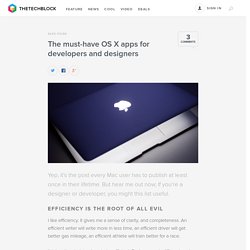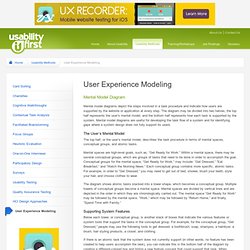

The Encyclopedia of Human-Computer Interaction, 2nd Ed. Jesse James Garrett: experience design and information architecture resources. Must have OS X apps for UX/UI developers and designers. Yep, it’s the post every Mac user has to publish at least once in their lifetime.

But hear me out now; If you’re a designer or developer, you might this list useful. Efficiency is the root of all evil I like efficiency. It gives me a sense of clarity, and completeness. An efficient writer will write more in less time, an efficient driver will get better gas mileage, an efficient athlete will train better for a race. It takes time to learn how to be efficient. Interface On my MacBook Air 13”, I’ve hid my dock, to gain some vertical space for apps (yes, I know I can run apps in fullscreen). I run a few apps in fullscreen: SublimeText, Spotify, and Mail. I find it faster to run apps using the spotlight shortcut [Cmd + Space], and type in the first few letters of the app. Categorisation I have all my apps divided into four categories/folders: “Apple” (Dictionary, FaceTime, Photobooth, etc.). Apps (In order of usage) Dropbox for storage/backup.
Google Chrome for browsing. SublimeText for coding. UX Inspiration by Epic Bagel. Usability Glossary - User Experience Modeling. Mental Model Diagram Mental model diagrams depict the steps involved in a task procedure and indicate how users are supported by the website or application at every step.

The diagram may be divided into two halves; the top half represents the user’s mental model, and the bottom half represents how each task is supported by the system. Mental model diagrams are useful for developing the task flow of a system and for identifying gaps where a system design does not fully support its users. The User’s Mental Model The top half, or the user’s mental model, describes the task procedure in terms of mental spaces, conceptual groups, and atomic tasks.
Mental spaces are high-level goals, such as, “Get Ready for Work.” The diagram shows atomic tasks stacked into a tower shape, which becomes a conceptual group. Supporting System Features Below each tower, or conceptual group, is another stack of boxes that indicate the various features or system tools that support the tasks in the conceptual group.
User Experience - Stack Exchange. Uxfind - Search. The Graphical User Interface - Time for a Paradigm Shift? The Five Competencies of User Experience Design. By Steve Psomas Published: November 5, 2007 Throughout my career as a user experience designer, I have continually asked myself three questions: What should my deliverables be?

Will my deliverables provide clarity to me and their audience? Where do my deliverables and other efforts fit within the spectrum of UX design? “This framework comprises the competencies a UX professional or team requires.” I have found that, if I do not answer these questions prior to creating a deliverable, my churn rate increases and deadlines slip. When attempting to answer the third question, I use a framework I discovered early in my career: The Five Competencies of User Experience Design. This framework comprises the competencies a UX professional or team requires.
Information Architecture What are users’ primary goals, and how can they achieve them using the application? Interaction Design Questions the interaction designer must address include: What layout pattern would work best? Usability Engineering.